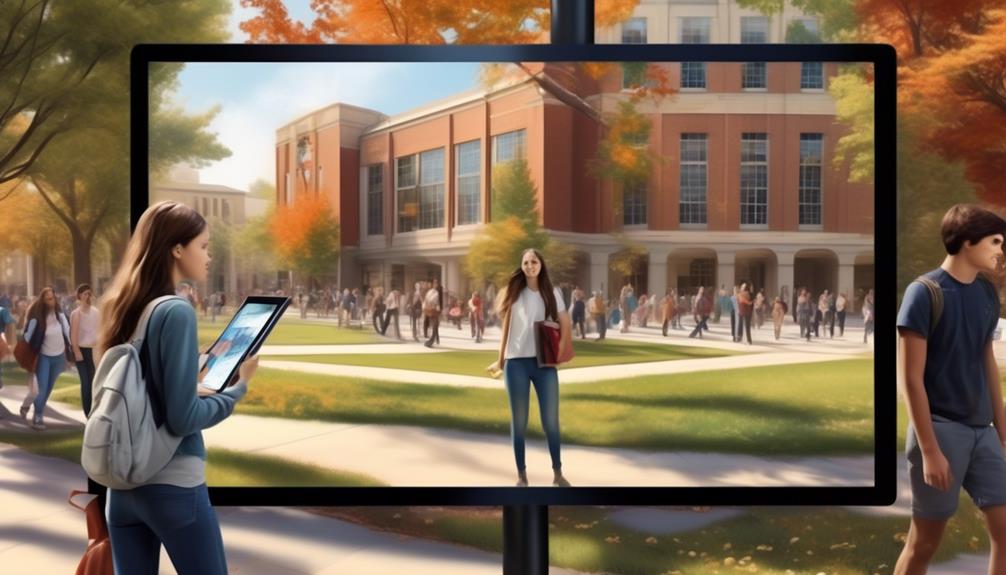As we navigate the ever-evolving landscape of higher education marketing, the concept of interactive advertising is akin to a compass, guiding us towards a more engaging and immersive approach to reaching prospective students.
The use of interactive content has become increasingly vital in capturing the attention and interest of today's digitally savvy generation. However, the question remains – how can this innovative form of advertising be effectively harnessed within the higher education sector, and what are the potential benefits and challenges that come with it?
Key Takeaways
- Interactive advertising in higher education enhances brand awareness and effectively connects with the target audience.
- Utilizing digital content and AI tools strategically increases visibility and click-through rates, maximizing return on investment.
- Short-form videos and personalized CTAs are effective strategies for capturing and maintaining student engagement.
- Leveraging AI tools, such as generative AI and programmatic advertising, can optimize student engagement and lead generation in higher education.
Concept and Advantages of Interactive Advertising

We believe that interactive advertising revolutionizes traditional marketing by fostering active engagement and participation from the audience, leading to a more immersive and memorable experience. In the context of higher education, interactive advertising holds immense potential for increasing brand awareness and reach among prospective students. By utilizing interactive elements such as video content and personalized CTAs, higher education institutions can create more impactful marketing campaigns that resonate with their target audience. Leveraging digital channels like the Google Display Network, these institutions can engage with potential students in a more dynamic and personalized manner, ultimately enhancing the effectiveness of their marketing strategy.
The advantages of interactive advertising in higher education are clear. It allows for real-time feedback and data gathering, enabling institutions to better understand and target their audience. This, in turn, leads to higher levels of audience engagement and interaction, increasing the likelihood of conversion and brand recall. Furthermore, the immersive and memorable nature of interactive advertising can contribute to increased brand loyalty and advocacy among prospective students, ultimately driving better results and return on investment for higher education marketing efforts.
Utilizing Interactive Advertising in Higher Education Marketing
With the potential for increased brand awareness and audience engagement established, the focus now shifts to practical strategies for utilizing interactive advertising in higher education marketing.
Short-form videos are proving to be an effective tool for engaging prospective students and increasing brand awareness.
Leveraging responsive ads that automatically scale assets can significantly boost conversion rates.
Targeting specific keywords after visitors have engaged with relevant content plays a crucial role in pay-per-click (PPC) strategies for higher education marketing.
Additionally, incorporating personalized calls to action (CTAs) can enhance visitor engagement and conversions on higher education websites.
Furthermore, developing content strategies to address high-volume search queries and optimizing existing content for search engine visibility is essential in the digital landscape.
Social media platforms offer a fertile ground for interactive advertising, allowing higher education institutions to reach a wide audience of students through engaging video content and ads.
Examples and Success Stories of Interactive Advertising

Interactive advertising in higher education has brought about remarkable success stories through various digital marketing strategies.
For instance, the use of generative AI has enabled the creation of personalized CTAs and digital content, effectively engaging prospective students and increasing brand awareness.
Additionally, the implementation of AI tools for lead generation and programmatic advertising has significantly impacted enrollment marketing efforts, leading to a higher student yield.
Furthermore, the utilization of geofencing and retargeting ads has proven successful in reaching and re-engaging potential students.
Short-form video strategies have also played a crucial role in capturing the attention of prospective students and driving enrollment.
Moreover, the incorporation of chatbots for personalized student support has enhanced the overall experience for potential students, contributing to the success of interactive advertising in higher education.
Interactive Advertising Platforms for Higher Education
Utilizing programmatic advertising, higher education institutions reshape their outreach strategies to guide relevant students toward enrollment, enhancing the effectiveness of their marketing efforts. Interactive advertising platforms offer diverse tools and capabilities tailored for higher education institutions to engage with prospective students and enhance brand awareness.
Here are some key elements of interactive advertising platforms for higher education:
- Personalized Digital Content: Tailoring ad content to specific target audiences increases engagement and the likelihood of conversion.
- AI Tools for Optimization: Implementing artificial intelligence tools enables the automatic optimization of ad placements and bids to reach the most relevant audiences effectively.
- Google Ads: Leveraging Google's extensive advertising network and targeting options can significantly enhance the reach and impact of higher education marketing campaigns.
- Enhanced Targeting Capabilities: Utilizing advanced targeting features allows higher education institutions to direct their ads to specific demographics, interests, and behaviors, ensuring that they reach the most relevant prospective students.
Interactive advertising platforms are crucial in the education marketing landscape, offering institutions the means to effectively engage with their target audience and drive enrollment.
Interactive Advertising Strategies for Student Engagement

Interactive advertising strategies for student engagement revolve around utilizing various digital tools and content formats to foster meaningful interactions and drive enrollment.
In higher education, it's essential to capture prospective students' attention and create brand visibility. Short-form video content, particularly for virtual and facility tours, proves to be highly engaging and effective in increasing brand awareness. Additionally, linking these short-form videos to long-form content provides detailed information, catering to the diverse needs of prospective students.
Personalized calls to action (CTAs) play a crucial role in capturing and maintaining student engagement. By tracking visitor behavior, higher education institutions can tailor their approach, increasing the chances of lead identification and effective lead nurturing.
Moreover, employing responsive ads that automatically scale assets and utilizing multiple headlines, descriptions, and images significantly enhances conversions and click-through rates.
In the evolving landscape of education marketing, AI tools, including generative AI, are becoming increasingly valuable for creating and distributing digital content, ultimately shaping interactive advertising strategies to optimize student engagement.
As individual-level targeting diminishes, exploring alternative data collection and marketing methods becomes imperative to maintain effective interactive advertising strategies and ensure continued student engagement.
Maximizing ROI With Interactive Advertising
Maximizing ROI with interactive advertising necessitates a thorough understanding of the evolving digital landscape and proactive adaptation to emerging technologies and data privacy measures. In the context of higher education marketing, this is particularly crucial for effectively reaching prospective students and enhancing brand awareness.
To achieve this, we must focus on the following key strategies:
- Utilize Advanced Analytics: Implement Google Analytics 4 or alternative analytics solutions to gather actionable insights, as Universal Analytics will cease recording new data after January 2024.
- Prepare for Cookie Changes: With Google and Apple disabling 3rd party cookies, prepare for the future by exploring alternative targeting methods and understanding the implications for personalized advertising.
- Leverage Generative AI Tools: Embrace generative AI tools for content creation, but ensure that bias and diversity, equity, and inclusion (DEI) considerations are addressed, and establish a robust process for publishing AI-generated content.
- Embrace Short-Form Videos: Emphasize short-form videos in marketing campaigns, as they offer enhanced engagement, better brand awareness, and increased opportunities for retargeting campaigns.
Implementing Interactive Advertising Campaigns

We will incorporate cutting-edge interactive advertising techniques to effectively engage and connect with our target audience in higher education marketing.
Implementing interactive advertising campaigns in higher education requires strategic utilization of digital content and AI tools to attract prospective students and enhance brand awareness. Programmatic advertising is a key component, enabling us to reach a wider audience and make a lasting impression.
Utilizing responsive ads will allow us to automatically adjust content for different devices, increasing visibility and click-through rates. Moreover, the use of multiple headlines, descriptions, and images in responsive display ads can significantly boost conversions.
Additionally, leveraging remarketing lists for search ads (RLSA) can help maximize return on investment by targeting individuals who've already engaged with our institution's website. Furthermore, integrating chatbots into our campaigns will provide instant and personalized support to students, addressing frequently asked questions and offering guidance.
As marketing leaders in higher education, we recognize the importance of these strategies and will implement them to create impactful interactive advertising campaigns.
Frequently Asked Questions
How Do Universities Advertise Themselves?
We advertise ourselves through SEO strategies to rank high on search engines, PPC techniques to generate traffic and leads, content marketing to build a strong brand presence, programmatic advertising to precisely target and reach students, and social media marketing to increase awareness and connect with potential students.
How Do You Market a College to Prospective Students?
When marketing a college to prospective students, we focus on personalized virtual tours, responsive ads, and lead nurturing strategies for maximum engagement. By combining remarketing lists and custom intent audiences, we optimize PPC campaigns for increased ROI.
Which Type of Digital Marketing Is Best for Students?
We find that personalized CTAs on websites, responsive ads, and short-form video strategies are best for reaching students. Leveraging remarketing lists, custom intent audiences, and combining PPC strategies prove effective for engaging prospective students.
How Much Do Colleges Spend on Marketing?
We spend a hefty average of $2,229 per student per year on marketing. Public colleges pinch about $400 less compared to private ones. The top 10% splurge an average of $5,447 per student.
Conclusion
As we've seen, interactive advertising in higher education isn't just a trend, but a powerful tool for student engagement and enrollment.
By creating immersive and personalized experiences, universities can connect with prospective students on a deeper level and increase their likelihood of enrollment.
The success stories and strategies we've explored prove that interactive advertising is more than just a theory – it's a reality that evokes excitement and emotion in both students and universities.




